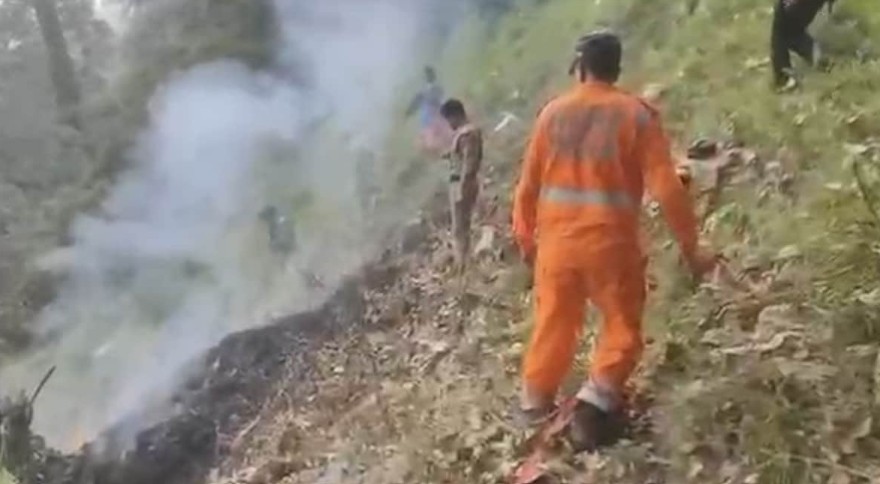Tragedy Strikes Kedarnath Again: Seven Dead in Chopper Crash, Raising Alarms Over Himalayan Heli-Services
Rudraprayag, Uttarakhand – June 15, 2025 – A pall of gloom has descended upon the sacred Kedarnath Dham region following a devastating helicopter crash that claimed the lives of all seven individuals on board, including the pilot. The Aryan Aviation helicopter, ferrying pilgrims from the revered temple back to Guptkashi, plunged into a forest between Gaurikund and Sonprayag, marking the fifth such incident in the treacherous Himalayan terrain in just six weeks, and leading to urgent calls for a comprehensive investigation and stricter safety protocols.
The tragic incident occurred early this morning, at approximately 5:20 AM, just ten minutes into its flight. On board were six pilgrims – five adults and a 23-month-old child – along with the 39-year-old pilot, Captain Rajbir Singh Chauhan, a resident of Jaipur. All occupants were tragically charred to death in the fiery aftermath of the crash, according to a statement issued by the Uttarakhand Civil Aviation Development Authority (UCADA).

A Sudden Turn in Weather and a Pilot’s Desperate Attempt
Eyewitness accounts and preliminary reports suggest that deteriorating weather conditions played a crucial role in the disaster. “The weather turned bad during the return journey. The pilot tried to move the chopper out of the valley but it crashed near Gaurikund,” stated Rahul Chaubey from the District Tourism Development. The challenging mountainous terrain and unpredictable weather patterns of the Himalayas often pose significant risks to aviation.
Garhwal Commissioner Vinay Shankar Pandey confirmed that one of the passengers was Vikram Rawat, an employee of the Badarinath Kedarnath Temple Committee (BKTC) from Ukhimath in Uttarakhand, highlighting the local connection to the tragedy.
Heart-Wrenching Loss: The Victims Identified
The crash has brought immense grief to families across India. Among the deceased are three members of the Jaiswal family from Maharashtra’s Yavatmal: Rajkumar Suresh Jaiswal, Shraddha Jaiswal, and their infant daughter, Kashi Rajkumar Jaiswal, who was just 23 months old. In a poignant twist of fate, their son, Vivaan, was spared, having stayed back with his grandfather, avoiding the ill-fated flight. The other pilgrims have been identified as 66-year-old Vinod Devi and 19-year-old Trishti Singh, both from Uttar Pradesh. Captain Rajbir Singh Chauhan, the experienced pilot, also perished in the crash.

Swift Response Amidst Challenging Terrain
Local residents, who were out collecting fodder for their cattle, were the first to spot the crashed helicopter, immediately alerting officials. Teams from the National Disaster Response Force (NDRF) and State Disaster Response Force (SDRF) rapidly mobilized, reaching Gaurikund by 7 AM. From there, they commenced a challenging trek to the remote incident site, initiating rescue operations at 8:55 AM.
Despite the swift response, the ferocity of the crash and the resulting fire meant there were no survivors. All seven bodies have been recovered, but Inspector General Rajiv Swaroop confirmed the grim reality: “Since it is difficult to identify the bodies, a DNA test will be conducted before handing them over to the families.” This necessary step underscores the devastating impact of the incident.
Rising Concerns: A Pattern of Accidents
This latest tragedy is particularly alarming as it marks the fifth helicopter accident since the portals of the Himalayan temple Kedarnath opened on May 2, bringing the total death toll to 13 within a mere six weeks. Just last week, on June 7, a helicopter en route to Kedarnath was forced to make an emergency landing on a highway in Uttarakhand after developing a technical snag during take-off. That incident saw the helicopter come dangerously close to buildings, with its tail rotor falling on a parked car. Miraculously, the five pilgrims on board escaped safely, though the pilot sustained minor injuries. Other incidents, including hard landings and minor technical glitches, have also been reported, highlighting a concerning trend in the region’s heli-operations.
Uttarakhand Chief Minister Pushkar Singh Dhami expressed his deep sorrow, sharing the “extremely distressing news” on X (formerly Twitter) and confirming that rescue teams were engaged in relief efforts.
Government Responds: Calls for Stricter SOPs and Expert Probe
The escalating number of incidents has prompted immediate action from the state government. Chief Minister Dhami has issued strict instructions regarding helicopter operations in Uttarakhand, calling for the urgent formulation of stringent Standard Operating Procedures (SOPs) for heli-services in the state.
“Chief Minister Dhami said that a strict SOP should be prepared for the operation of heli services in the state, in which a complete check of the technical condition of the helicopter and taking accurate weather information before the flight should be made mandatory,” reported news agency ANI. He has further directed the Chief Secretary to constitute a committee of technical experts to meticulously prepare this crucial SOP, ensuring comprehensive safety checks and robust weather monitoring are in place before any flight.
As a precautionary measure, the Directorate General of Civil Aviation (DGCA) had already reduced the frequency of helicopter operations to the Char Dham shrines (Kedarnath, Badrinath, Gangotri, and Yamunotri) and is carrying out enhanced surveillance, reviewing operations for any further necessary actions.
The Aircraft Accident Investigation Bureau (AAIB) will be probing the crash, conducting a thorough inquiry to determine the exact cause of the accident, including technical failures, human error, and environmental factors. The findings of this investigation will be crucial in implementing corrective measures to prevent such tragedies in the future and ensure the safety of pilgrims undertaking the arduous journey to the revered Himalayan shrines. The repeated incidents serve as a grim reminder of the inherent risks in operating in challenging high-altitude environments and underscore the absolute necessity of uncompromising safety standards.

